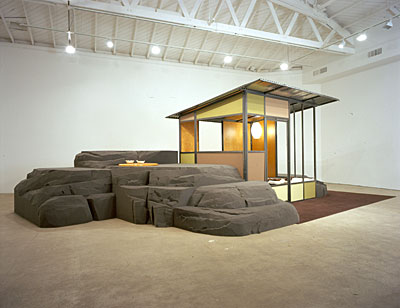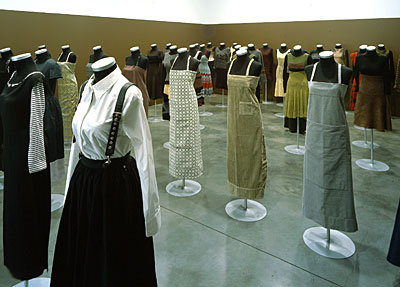
I got to see the Andrea Zittel "Critical Space" exhibit at LA MOcCA this weekend and it was (to no one's surprise) great. But it left me a little thrown off. I'd been largely acquainted with Zittel's work through reproductions and criticism, so going through it on my own led me to some things I hadn't really thought of about her work, and they weren't pretty. Here goes...

It's hard not to think of Zittel's work in terms of consumables. Mimicing a design studio, she makes delightful objects that one want to acquire. Looking through the exhibit, it was hard to ignore how many of these things were meant for her own use, and how others had been "customized" for collectors (I'm especially fond of the idea that Peter Norton needs a tidy little office from A-Z Administrative Services). I love art that can be part of the exchange economy as well as the economy of ideas, but a little light went off when someone said about Zittel's work that she "was alone a lot".
There's a monastic tradition in which one withdraws from the world to contemplate and pray and seek connection to god through solitude. However, asceticism ain’t cheap. In Zittel’s sculpture of solitude, one senses that moments alone for reflection are privileges, not rights. The gradual transition from severity to formal experimentation in her A-Z Personal Uniforms (above) implies a drift from discipline to austere luxury. The Met-Home just-so-ness of her structures – from the archly ironic airstream-inspired escape pods to the IKEA-slickness of her customized comfort units, there’s a feeling that the works perhaps too eagerly leapt into the embrace of the exchange economy. Aping a design agency is, on the one hand, clever and subversive (code for “good” in most art discourse, but not here) but on the other hand, a little bit too close to providing the kind of design advice persons in the position of providing patronage have come to expect from artists.
Let’s not kid ourselves, as great as Zittel’s work is as sculpture, it has limited implications for the design community – let alone for areas of social justice it nearly addresses (such as affordable housing). This is privacy for the privatized era. Solitude for the socially superior, hair shirts for those who wish to now and then trade in their Armani and Prada. The best thing that can come from this show (aesthetic delight notwithstanding) is that socially engaged designers might visit and adapt Zittel’s down market notions for populations in need of efficient, workable domestic design.